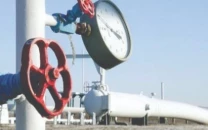Clearing a path for the growth of agricultural economy
The irrigation system needs care and maintenance to function smoothly.

Irrigated lands contribute more than 90% to total agriculture production, which accounts for 22% of the GDP and the employment of 54% of the labour force. PHOTO: FILE/REUTERS
The agriculture sector is dependent on water, which is mostly supplied through a complex network of small and large canals. Pakistan has the distinction of having the largest contiguous gravity flow irrigation system in the world. The irrigation system serves as a lifeline for sustainable agriculture in this part of the world, which has an arid to semi-arid climate. Irrigated lands contribute more than 90% to total agriculture production, which accounts for 22% of the GDP and the employment of 54% of the labour force.

Punjab’s vast irrigation system is controlled through a well-designed network of 14 barrages constructed on the Indus River and its tributaries at Jhelum, Chenab, Ravi and Sutlej. These rivers carry a substantial quantity of silt-load, which is deposited in the distributaries and minors where the velocity of flow is comparatively low. Canals supply water to the tail-portions of these distributaries and minors, where the speed of water flow is lowest; therefore, farmers located at the tail-reaches suffer serious shortages of canal-water because of heavy siltation problems which leads to unrest.
Various water-related studies conducted by the Punjab Irrigation Department have revealed that the siltation of channels adversely affects the distribution of canal supplies in two ways: firstly, it reduces the channels’ carrying capacity; and secondly, the outlets located in the head-reaches start drawing more water than their authorised share due to raised water levels. Regular desilting of channels has, therefore, become a regular feature to mitigate this problem. It is important to mention that a recent study conducted by a Chinese firm shows that the storage capacity of Pakistan’s famous Tarbela Dam (built in 1978) has declined from 9.6 million acre feet (MAF) to about 6.6 MAF only. This has happened due to continuous silting and sedimentation.
Punjab Irrigation Department first started desilting canals during the regime of late chief minister Ghulam Haider Wyne, who made it an annual feature. Since then, PID gregariously conducts this campaign to clean its canals of silt and other garbage.
While providing a detail of this year’s desilting plan, Punjab Irrigation & Drainage Authority Communication & Education Manager Najam Abbas Najmi says that the desilting plan for 2012-13 has been compiled from data prepared by various irrigation zones of the Irrigation Department. He adds that the plan includes desilting of 638 channels covering 3,851.58 canal miles length and excavating 91.440 million cubic feet earthworks with the expected expenditure of Rs244.31 million. The desilting plan is being implemented as a concerted campaign in two phases as per the closure schedule notified by the Irrigation Department’s Indus Water Treaty and Regulation director.
Provincial Irrigation Secretary Khalid Masood Chaudhry told this scribe that the desilting campaign was proceeding smoothly. He hoped that it will significantly assist in cleaning the canals and helping farmers, especially at the tail-ends.
Keeping in view the extraordinary importance of desilting of canals, it is essential that this exercise be conducted with full verve and professional competence so that it can help ensure the continuous flow of canals and ensure availability of water at tail-ends. Otherwise, our canals will be heavily silted; making them redundant and useless for the farmers.
Published in The Express Tribune, February 11th, 2013.
Like Business on Facebook to stay informed and join in the conversation.



















COMMENTS
Comments are moderated and generally will be posted if they are on-topic and not abusive.
For more information, please see our Comments FAQ